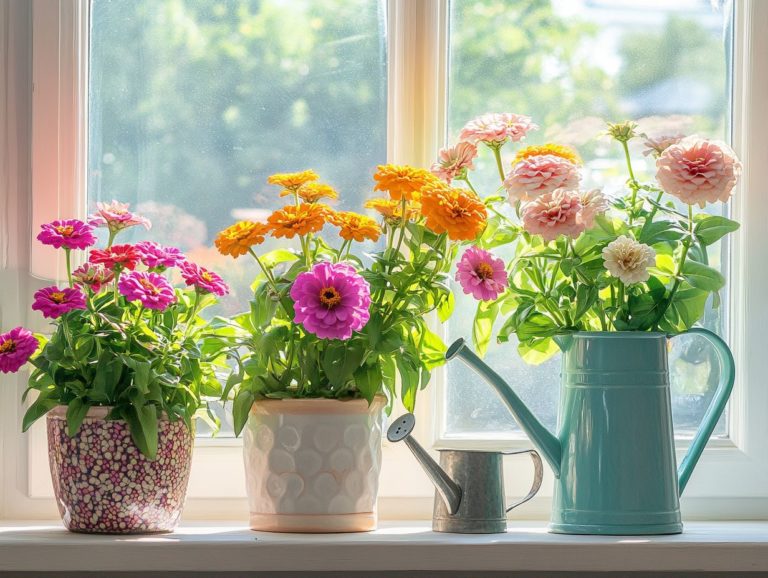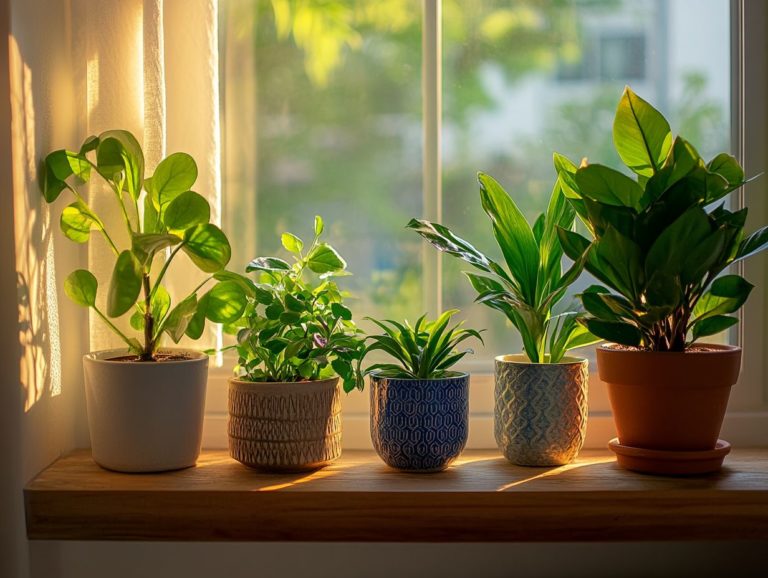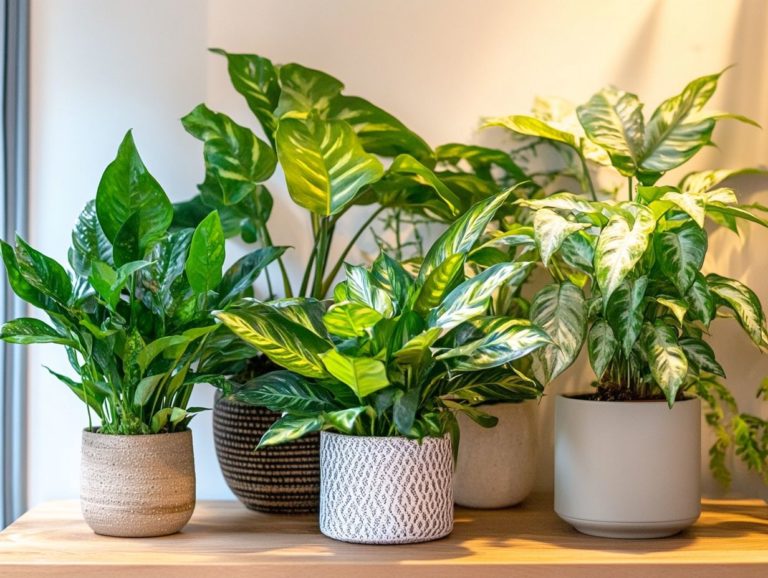10 Tips for Caring for Indoor Foliage Plants
Indoor plants have the remarkable ability to transform your space into a vibrant oasis! Maintaining their health, however, requires some knowledge.
Whether you re a seasoned enthusiast or just starting your plant parent journey, understanding the basics of plant care is essential.
This guide offers ten practical tips designed to help your indoor greenery thrive, from selecting the ideal plants to keeping an eye out for pests.
Uncover answers to common questions that will enhance your plant care experience and ensure your leafy companions flourish beautifully.
Contents
- Key Takeaways:
- 1. Choose the Right Plants for Your Home
- 2. Provide Adequate Light
- 3. Water Properly
- 4. Use Quality Potting Soil
- 5. Fertilize Regularly
- 6. Monitor for Pests and Diseases
- 7. Prune and Trim as Needed
- 8. Rotate Plants for Balanced Growth
- 9. Keep a Consistent Temperature and Humidity and Observe Common Diseases
- 10. Avoid Drafts and Air Conditioning
- How Can You Tell If Your Indoor Plants Are Healthy?
- Frequently Asked Questions
- What are the 10 tips for caring for indoor foliage plants?
- How do I choose the right plants for my space?
- How often should I water my indoor foliage plants? (Watering Schedules)
- What kind of soil is best for indoor foliage plants? (Soil Quality)
- Can I use regular household fertilizer on my indoor plants? (Fertilizer Application)
- Do I need to worry about pests on my indoor foliage plants? (Pest Prevention)
Key Takeaways:
- Choose the right plants for your home based on light and humidity levels!
- Ensure your plants receive the right amount of light for thriving growth!
- Water your plants correctly to avoid over or under-watering!
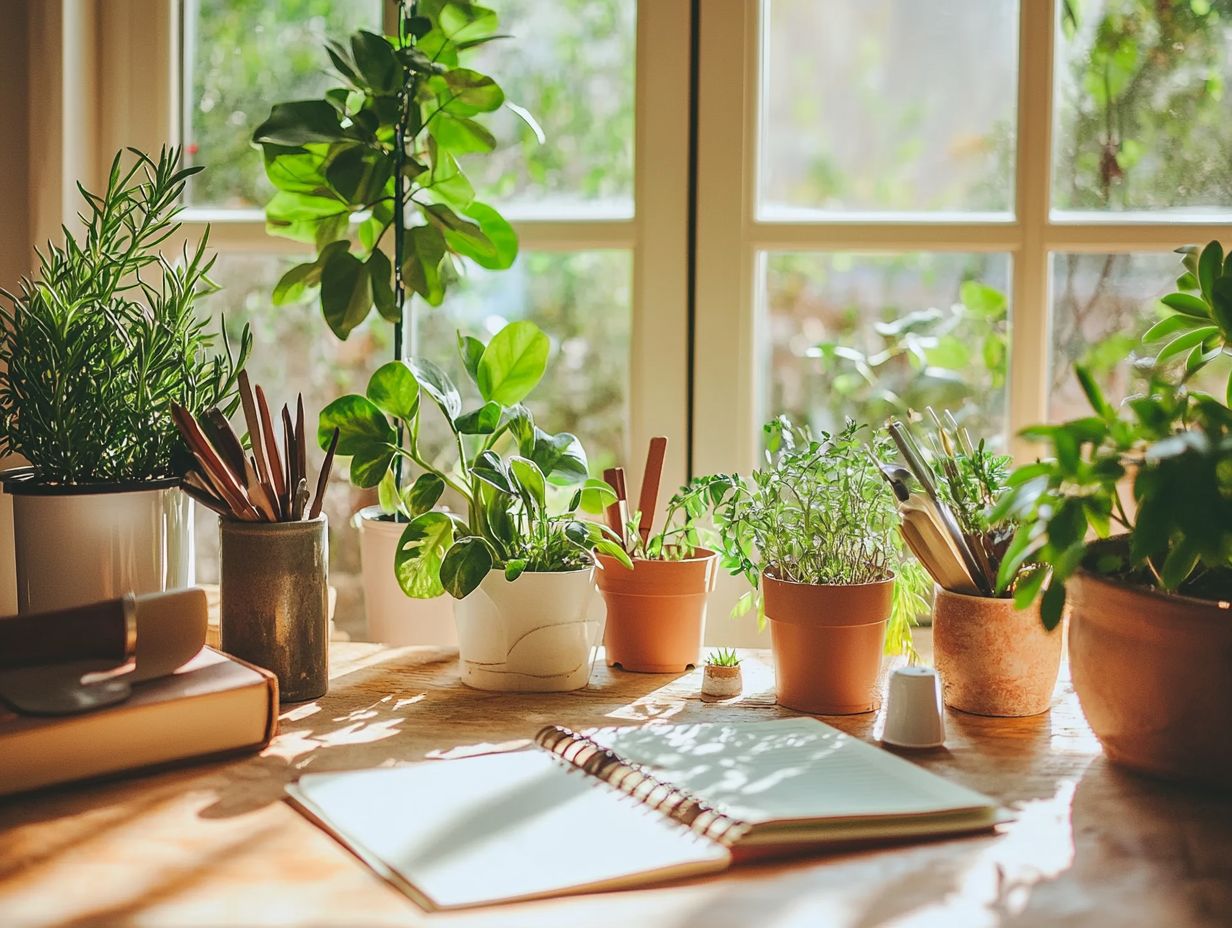
1. Choose the Right Plants for Your Home
Choosing the right plants is crucial for creating a thriving indoor environment. Selecting plants that match your living conditions like light exposure and humidity levels can make a big difference!
By picking the right tropical flowers or low-light champions like the ZZ plant or pothos, your indoor space can remain vibrant and inviting.
As you decide which houseplants to welcome, evaluate how much natural light each room gets. Beautiful options like Monstera deliciosa thrive in bright, indirect light, while the adaptable Peace Lily can flourish even in lower light.
Humidity levels matter too! Many tropical plants love a bit more moisture in the air; neglecting this can lead to unsightly leaf browning.
Don’t forget about soil quality, as it significantly impacts drainage and nutrient retention. Making poor choices in plant selection can result in stunted growth or pest infestations!
2. Provide Adequate Light
Light exposure is vital for your plants’ health! It directly influences their growth and overall vitality.
Different species have unique light needs. For instance, succulents and cacti bask in full sunlight, while ferns and snake plants thrive in indirect light.
Observe how sunlight enters your spaces throughout the day. Pay attention to areas that receive direct, filtered, or low light.
To check light intensity, place a plant in a spot for a week and monitor its response. If some plants struggle despite what seems like an ideal placement, consider adding artificial lighting options like LED grow lights or fluorescent bulbs!
This ensures they receive the spectrum of light necessary for healthy growth, especially during darker months!
3. Water Properly
Proper watering techniques are essential for your indoor plants’ health! Both overwatering and underwatering can lead to serious issues like root rot or stress.
Consider using bottom watering; this method allows your plants to absorb moisture gradually and reduces the risk of pooling at the surface.
Keep an eye on soil moisture levels with a moisture meter or by simply checking with your finger. Regular assessments help determine when it s time to water!
These practices not only promote healthy root development but also boost the overall vitality of your plants, giving them the best chance to thrive.
4. Use Quality Potting Soil
Quality potting soil is essential for optimal plant growth. It affects drainage, moisture absorption, and nutrient availability, all vital for your indoor plants’ health.
Select the right mix for your specific species. This ensures each plant gets the perfect balance of these crucial elements.
Many plants thrive in a well-aerated blend that encourages root development. Others might need a denser mix to retain moisture effectively.
Regular soil maintenance matters. Check pH levels and replenish nutrients often to avoid common issues like root rot.
By staying attentive, you can create a thriving environment for all your houseplants, even the most delicate ones.
5. Fertilize Regularly
Applying fertilizer regularly is crucial for your plants’ nutrition. This helps keep their foliage lush and healthy, especially during growth phases.
When choosing fertilizer synthetic, organic, or slow-release consider its impact on your plants’ well-being. Liquid fertilizers offer quick absorption, while granulated types require monthly applications.
Adjust the frequency based on your plants’ needs. Flowering plants often appreciate more frequent feeding when in bloom.
Watch for signs like yellowing leaves or stunted growth; these indicate it’s time to rethink your fertilization schedule. Ensuring your plants get the right nutrients paves the way for robust growth.
6. Monitor for Pests and Diseases
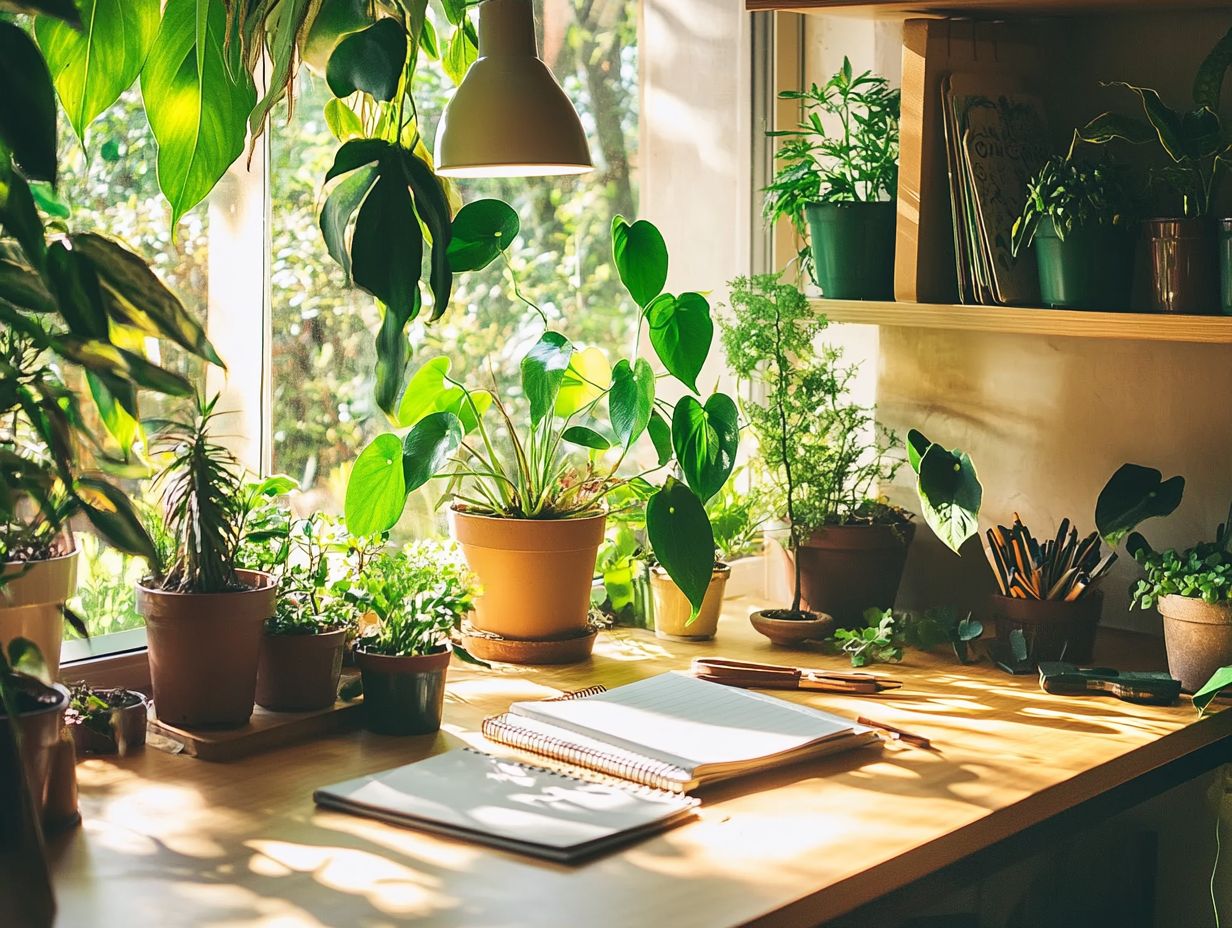
Monitor your indoor plants for pests and diseases consistently. Early detection is key to preventing infestations from getting out of control.
Unwanted visitors like spider mites and mealybugs can harm your plants. Look for yellowing leaves, wilting, or webbing on leaves these are signs of trouble.
Protect your plants with preventive strategies. Keep the environment clean, ensure good air circulation, and use insecticidal soap or neem oil when necessary.
Educate yourself about common pests to maintain a healthy plant collection.
7. Prune and Trim as Needed
Prune and trim your indoor plants to maintain their health and encourage new growth. This helps monitor root health and prevents overcrowding in pots.
This process rejuvenates your plants by directing energy towards fresh leaves and vibrant flowers. Different species react differently to pruning tropical plants may thrive with light trimming, while hardwood species might need more substantial cuts.
Timing is important. Spring is usually the best season for most varieties as they enter their active growing phase. While repotting, inspect the roots carefully to avoid any damage.
8. Rotate Plants for Balanced Growth
Rotating your indoor plants regularly is a smart strategy for promoting balanced growth and ensuring each side of the plant receives ample light exposure an essential factor for their overall health and vitality.
By changing the orientation of your plants, you can prevent uneven growth patterns. This helps avoid lopsided or weak structures.
Establishing a rotation schedule is simple. You can customize it based on your home s lighting perhaps every two weeks or monthly.
Pay attention to which areas of your home get the most light. This way, you can refine your plan and help each plant get optimal rays. This simple practice leads to lush, vibrant foliage that transforms your space into a verdant oasis.
9. Keep a Consistent Temperature and Humidity and Observe Common Diseases
Maintaining a consistent temperature and humidity is crucial for the well-being of your indoor plants. Fluctuations can induce stress and impede growth, particularly for tropical species that thrive in high humidity environments.
To achieve this, regularly check the ambient conditions using a reliable thermometer and hygrometer. Monitoring these levels enables you to address any deviations promptly, making it easier to create an ideal environment for your plants.
For instance, if the humidity dips below a certain threshold, consider:
- Misting the leaves
- Using a humidifier
- Placing pebble trays filled with water near your plants
Remember, different species have unique needs; some may flourish in dry conditions, while others crave higher humidity. Understanding these preferences can significantly enhance plant health and growth. Additionally, be aware of the watering myths about indoor plants to ensure proper care.
10. Avoid Drafts and Air Conditioning
Act now to create a stable environment for your plants. Avoiding drafts and direct exposure to air conditioning is essential for keeping your plants happy. Sudden temperature changes can stress indoor plants and lead to issues you want to avoid.
To create a more stable environment for your greenery, it’s important to be mindful of where you position them in your living space. Keeping them away from windows that frequently open or vents can significantly cut down their exposure to cold drafts or hot air. You might also consider using room dividers or rearranging your furniture to provide a cozy shield against sudden fluctuations. Additionally, using the right nutrients can help your plants thrive; check out the top 10 fertilizers for thriving indoor plants for the best options.
A consistent temperature, free from abrupt changes, creates a secure atmosphere that encourages growth and vitality, ensuring your plants thrive.
How Can You Tell If Your Indoor Plants Are Healthy?
Determining the health of your indoor plants involves examining several key indicators, such as foliage vitality, growth patterns, and potential issues that can help you assess their overall condition and care requirements.
One of the most obvious signs of healthy plants is vibrant, rich green leaves free from discoloration or blemishes. In contrast, unhealthy plants often display yellowing or browning leaves, signaling possible nutrient deficiencies or overwatering. A steady growth rate is the hallmark of robust plants, while stunted growth may point to underlying problems. Healthy plants should also demonstrate good resistance to pests and diseases; those that are struggling might show signs of wilting or spots.
Regular maintenance, including timely watering following 5 expert tips for watering orchids indoors, fertilization, and proper pruning, is essential for enhancing plant vitality and longevity. This creates an environment that fosters flourishing growth, ensuring your green companions thrive beautifully.
What Are the Best Types of Indoor Plants for Beginners?
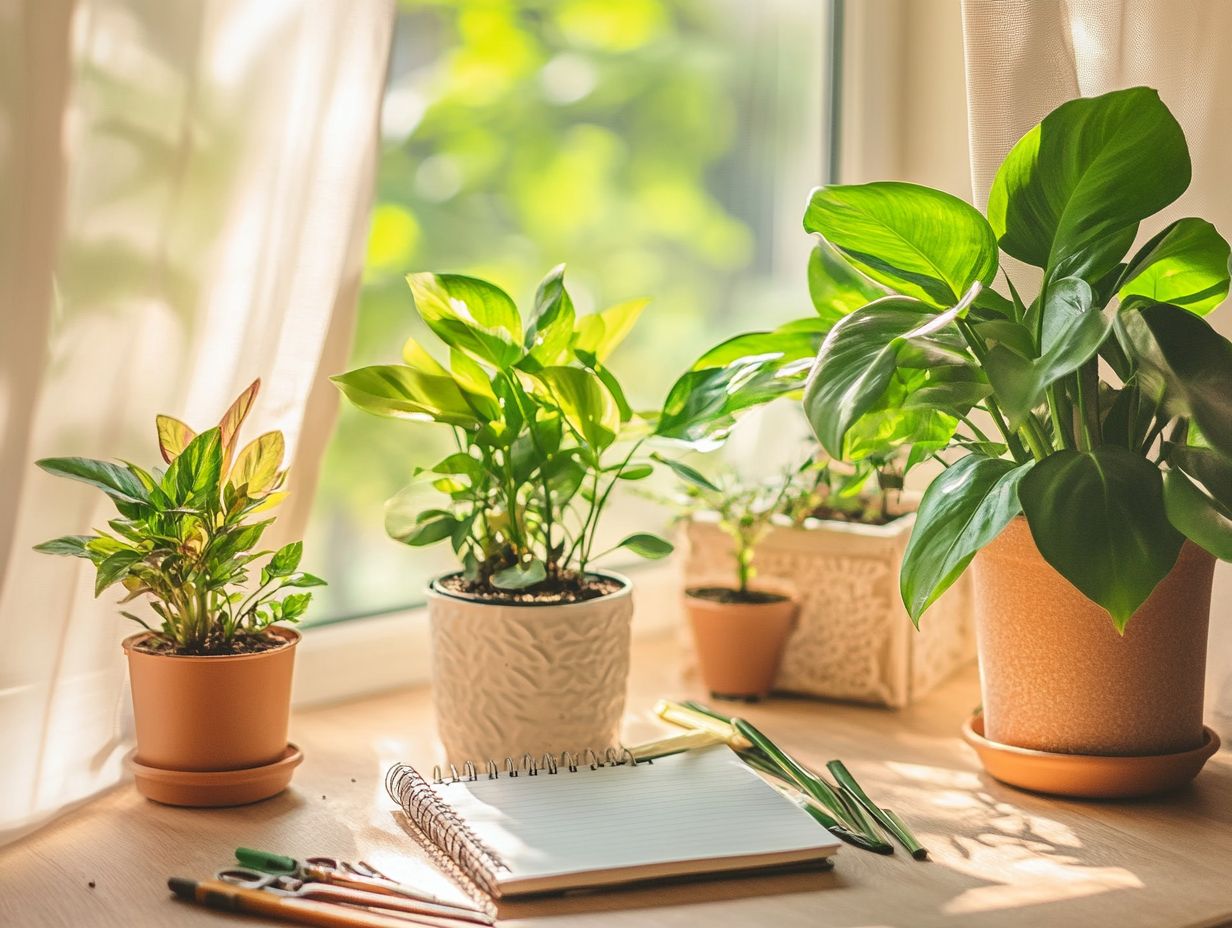
For beginners, choosing indoor plants that are easy to care for is essential in building your confidence and ensuring early success. Consider species like pothos, ZZ plants, and spider plants. These resilient varieties thrive in low-light conditions and require minimal upkeep, making them perfect companions as you embark on your indoor gardening journey.
These houseplants not only adapt well to various environments but also thrive on neglect, which is a win-win for newcomers. Pothos has beautiful trailing vines and can handle occasional missed waterings. ZZ plants are champions at surviving in dim light with very little moisture. On the other hand, spider plants are quite forgiving and prefer bright, indirect sunlight, making them a great choice. For best results, you may want to follow 5 tips for watering low-light plants, combining beauty with low maintenance.
To get started, make sure to place your new plants in well-draining pots and pay attention to their unique light and need for moisture for optimal growth. Additionally, avoid the top 7 mistakes in watering indoor plants by checking your plants regularly for pests and adjusting your watering routine according to the seasons to help them thrive.
What Are Some Common Mistakes to Avoid When Caring for Indoor Plants?
Avoiding common mistakes in caring for your indoor plants is crucial for preventing typical houseplant issues like overwatering and improper light exposure. These issues can ultimately lead to a decline in their health and vitality.
Establishing a consistent watering routine tailored to each plant s specific needs is essential. Neglecting this important step can lead to stress and even threaten the life of your greenery. Be mindful of the varying light requirements based on species to ensure your plants thrive instead of languishing in unsuitable conditions.
Stay vigilant against pests to prevent infestations. Regular inspections and preventive treatments can help you fend off problems before they take hold.
By incorporating these practices into your care routine, you can create a thriving indoor jungle that brings joy and beauty into your home.
How Often Should You Repot Your Indoor Plants?
Repotting your indoor plants at the right intervals is key to maintaining soil quality and fostering healthy growth. If you see signs like root crowding or poor drainage, act fast to repot your plants and give them a fresh home!
The frequency of repotting can vary significantly based on several factors, including the specific plant species and its growth rate. For instance, fast-growing plants like pothos or monstera might require repotting every year, while slower-growing varieties could happily thrive in the same pot for several years without a hitch.
When you do decide to repot, selecting a new container that s only slightly larger is crucial to minimize root stress. Pay close attention to root health; gently remove the plant from its pot and inspect the roots for any signs of rot or overcrowding. Healthy roots should feel firm and appear white, while brown or mushy roots mean it s time for some serious pruning.
What Are Some Creative Ways to Display Indoor Plants?
Creative ways to display indoor plants can truly elevate the aesthetic of your home while highlighting your favorite species. You have the power to transform any space into a vibrant indoor garden that reflects your unique style.
Consider incorporating elements like plant shelves to turn those empty walls into lush vertical gardens. Strategically placed hanging planters can add depth and intrigue to your decor, making your space feel more dynamic. For optimal growth, it’s important to understand the best practices for indoor plant soil care. Terrariums offer a fantastic opportunity to craft miniature ecosystems tailored to your plants’ specific light needs, showcasing both your creativity and care.
As you plan these displays, remember to consider not only the visual appeal but also the individual needs of each plant. Ensuring they thrive in their chosen environment is key. By balancing aesthetics with proper care, you’ll create lively, flourishing displays that brighten any room and bring a sense of tranquility to your living space.
How Can You Revive a Dying Indoor Plant?
Reviving a struggling indoor plant demands prompt and effective care strategies that tackle underlying issues, such as signs of overwatering, low humidity, and potential disease control. With the right care, your plants can bounce back to life!
- Assess the soil moisture. Simply insert your finger about an inch into the soil; this will reveal whether it s too dry or too wet.
- Examine the leaves for any pests like aphids or spider mites, which can wreak havoc if not dealt with quickly. Should you discover any pests, employing insecticidal soap or a gentle neem oil solution a natural pesticide derived from the seeds of the neem tree can be quite effective.
- Ensure your plant is basking in adequate light for optimal growth. Sometimes, relocating it to a spot with better lighting can yield remarkable results.
Regularly monitor these aspects and keep an eye on your plant s recovery. Make adjustments to its care as needed to promote healthy regrowth.
Frequently Asked Questions
What are the 10 tips for caring for indoor foliage plants?
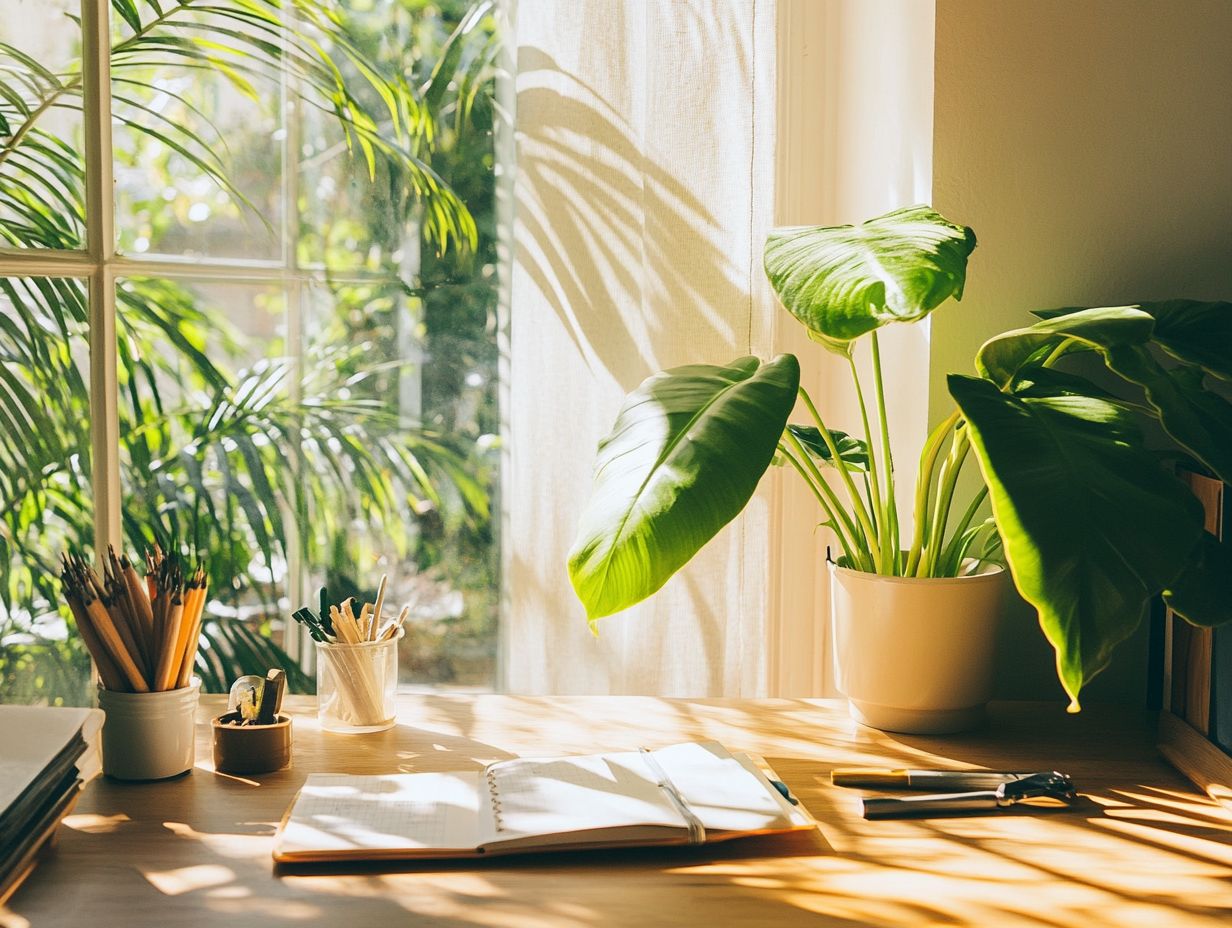
- Choose the right plants for your space: Consider factors like lighting and temperature before selecting indoor plants.
- Provide adequate lighting: Most indoor foliage plants prefer bright, indirect light.
- Water regularly but not too much: It’s important to find the right balance of watering for each plant.
- Use well-draining soil: The soil should easily drain excess water to prevent root rot.
- Monitor humidity levels: Some plants thrive in high humidity, while others prefer drier air.
- Fertilize as needed: Indoor plants may benefit from occasional fertilizing to provide essential nutrients.
- Prune and trim: Regularly remove dead or damaged leaves and branches to promote healthy growth.
- Keep an eye out for pests: Regularly check for any signs of infestation.
- Rotate your plants: To encourage even growth and prevent leaning, rotate them every few weeks.
- Seek help if needed: If you’re unsure about caring for a specific plant, ask a local nursery or expert for advice.
How do I choose the right plants for my space?
Consider factors like lighting, temperature, and size before selecting indoor plants. Some plants may require more sunlight or space than others, so research each plant’s specific needs.
How often should I water my indoor foliage plants? (Watering Schedules)
The frequency of watering depends on the type of plant and its individual needs. It’s important to find the right balance of watering not too much or too little to keep your plants healthy.
What kind of soil is best for indoor foliage plants? (Soil Quality)
Indoor plants thrive in well-draining soil that holds moisture while allowing excess water to drain easily. Consider using a potting mix specifically designed for indoor plants.
Can I use regular household fertilizer on my indoor plants? (Fertilizer Application)
While some indoor plants may benefit from occasional fertilizing, it’s important to use a fertilizer specifically formulated for houseplants. Regular household fertilizer may contain chemicals or nutrients harmful to indoor plants.
Do I need to worry about pests on my indoor foliage plants? (Pest Prevention)
Indoor plants can be susceptible to pests, so regularly check for signs of infestation. If you notice pests, take prompt action to prevent them from spreading to other plants.
Start reviving your plants today!



